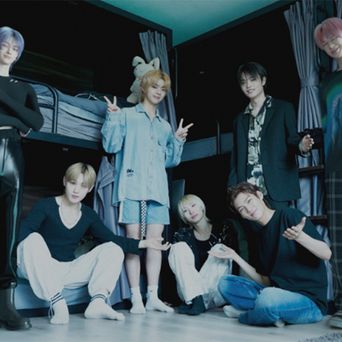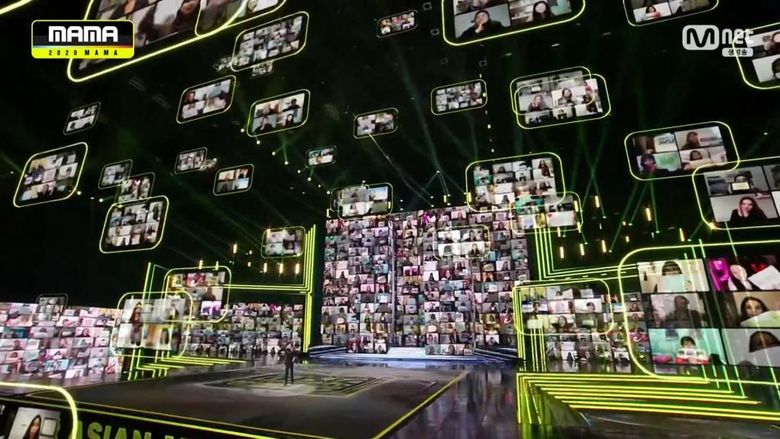
SUPERKIND Official
It was late spring 2020, the global COVID-19 pandemic was reaching its climax, and the realities of quarantine were beginning to take a toll on my mental health. Laid off from my job and unable to leave the house except for the most basic needs, even an introvert like myself began to feel more hopeless and isolated. During this time, there were two things that helped me reconnect to outside communities: virtual reality and K-Pop. I had very little exposure to either of the two prior to the pandemic; I had only tried Beat Saber in VR once or twice, and I hadn’t listened to much K-Pop in the last decade and only knew that a lot of people liked BTS – REALLY liked them. In virtual worlds, I found many other people in similar situations to my own, desperate for authentic interactions with a dose of escapism. As I learned more about K-Pop stan culture, I saw much of the same thing – the desire for authenticity found through the idols who could make their fans smile brightly enough to forget their troubles for a while, and the fandoms that formed around these artists. It didn’t take me long to understand the appeal of these groups and start interacting with other fans as one of their own.
Since the pandemic, more and more K-Pop entertainment companies have sought to evolve their groups’ concerts, concepts, and content, taking advantage of modern technology to deliver new experiences to their fans. At first, this was due to necessity – in 2020 and the majority of 2021, most live concerts and fanmeets were canceled due to the health risks, and organizers were forced to consider virtual options if they wanted to hold events at all. Even large-scale events like KCON and the MNET Asian Music Awards show utilized livestreaming and digital effects to bring K-Pop performances to their remote audiences.
At the same time, Gen Z represents the largest age demographic of global K-Pop fans (according to a survey analysis published by Towards Data Science), who grew up with digital platforms as their playground and tend to have a much lower tolerance for inauthentic experiences compared to previous generations. Reaching this target fan demographic is also a motivating factor for the K-Pop industry to pursue virtual outlets for their entertainment, both for accessibility to a growing international market, and for novelty—to stand out amid the flood of new K-Pop debuts and comebacks each year.
While there is a separate discussion to be had about the ethical concerns of the metaverse and virtual idols in K-Pop (see the article from the Center for Digital Society for more information), I would like to focus on what I think are the three main types of challenges that K-Pop entertainment companies and fans face when trying to bridge the gap between the real and virtual worlds: Bringing real idols to virtual stages, bringing virtual idols to real stages, and merging the two realities together.
Challenge #1: Bringing Real Idols to Virtual Stages
The most basic definition of a “Virtual stage” could be any performance that is not attended in-person. In its simplest form, this would include video recordings or livestreams of stage performances. This is very common in K-Pop already, with many major music shows recording idol performances that are then posted to YouTube and other social media platforms to be viewed by other fans unable to attend the shows themselves. This is also not limited to only K-Pop, as most artists around the globe promote their music releases through recordings and social media. The audience’s experience is limited to the box displaying the picture, whether phone or computer screen or television. However, technological advancements in recent years have drastically expanded these viewing possibilities.
SM Entertainment’s SMTOWN THEATRE in Seoul hosts a “Hologram” musical and other projection concerts from various groups under their label, using screens that surround the audience on three sides and a sound system that can simulate the acoustics of a much larger concert venue.
While video projections are one way to bring concert experiences to audiences, another method is to bring the audience into a virtual world with real idols. Through VR, all viewers are given the best seat in the house, without being dependent on physical location.
K-Pop girl group aespa, whose extensive lore incorporates virtual avatars for each of the members, held a VR concert at the SXSW Conference back in March. Fans donned VR headsets in the XR exhibition hall of the conference to view the 20-minute virtual concert. The technology was hosted by AmazeVR, who recorded the idols in 8K stereoscopic video then added them to virtual worlds built in Unreal Engine, complete with interactive elements for an immersive audience experience.
Some K-Pop artists take a more hands-on approach, using online video games to meet with fans and piloting their own virtual avatars to interact with them directly. NCT 127 hosted their own Roblox world in January 2023 for a fanmeet and pre-programmed concerts that ran over the course of several days. The game world was complete with quests to complete, exclusive items to collect, and portions of the concerts that allowed players to interact with the environment.
Several other K-Pop artists like TWICE, AleXa, and BLACKPINK have also used virtual spaces and the metaverse for events, and as this technology continues to progress, I anticipate we’ll see even more artists adopt these virtual stages in the future.
Challenge #2: Bringing Virtual Idols to Real Stages
As early as 2009, a virtual idol was being projected onto transparent screens to the delight of her passionate Japanese fans – voicebank singer Hatsune Miku. Accompanied by a live band, Miku has been touring internationally with her “Hologram” show, polishing the presentation with each passing year. I personally was able to attend a Miku Expo concert back in 2018, and it was a surreal experience to see her performance onstage and to sing along with her most popular songs.
K-Pop is now seeing more of their own virtual groups stepping onto the stage as well. At first glance, 5-piece boy group PLAVE doesn’t look much different from the Japanese virtual idols mentioned earlier, with their animation-inspired character designs, but these artists aren’t really virtual at all. Each member’s model is performed by a real human, capturing their voices, full-body motion, and facial expressions. Their primary means of interacting with their fans is through regular livestreams on Twitch and YouTube, where the members respond to comments and questions, perform dance challenges, and even use superpowers through their avatars. They have even made stage appearances on MBC’s “Show! MusicCore.”
PLAVE has yet to hold any concerts for their fans, but I am very interested to see how they might make use of their real-time motion capture technology during live performances.
One evolution of live concerts has been the use of augmented reality (AR), layering digital models and effects over real-world backgrounds. These digital enhancements can be added in post-production to pre-recorded performances, and many K-pop groups and performance shows have done this already. BTS even incorporated interactive AR elements into a live concert back in 2018. However, displaying virtual idols in physical spaces in real-time poses more of a challenge. The only way to change what the audience sees directly in front of them is through stage projections, smartphone applications, or specialized headsets.
No virtual K-Pop idols have used AR to perform live as of the time of writing, but an example of what this might look like has been demonstrated by British virtual rock band Gorillaz, who showcased Google’s emerging AR technology in December 2022. They created an app through which fans could watch the performance in their physical surroundings and interact with digital elements.
Only time will tell whether AR technology advances enough to bring more virtual idols to a physical stage, making full use of the three-dimensional space and transcending it.
Challenge #3: Merging Two Worlds into One
Both previously-mentioned sets of challenges, bringing real idols to virtual stages and virtual idols to real stages, are difficult enough to navigate individually – but what if you had to deal with both at the same time? That is exactly the issue that K-Pop boy group SUPERKIND has to face, as the first idol group in the world to debut a fixed lineup of both human and virtual members.
@playsuperkind Replying to @kari Who stole Seung’s lollipops? #PlaySUPERKIND #SUPERKIND #슈퍼카인드 #AI #human #NUKE #PRID #Idol #Kpop #SAEJIN #SEUNG #EUGENE #SiO #DAEMON #JDV ♬ dancin – dhn
In an interview with Korea JoongAng Daily, SUPERKIND’s leader Daemon shared, “Being the first of something is an honorable thing, although it adds some pressure too…But I actually think being the first is the easiest part. What’s more important from now on is to become an idol group that survives until the end. We are devoted to that goal – to make a stride in K-Pop history.”
For in-person concerts, SUPERKIND may also need to pioneer methods that don’t yet exist. Their company, DEEPSTUDIO, is no stranger to developing new tech, specializing in deepfake engines that gave rise to the photorealistic features of virtual members SaeJin and Seung. Even in the year since the group’s debut, the quality of the virtual members’ appearance and performance has continued to improve. The advancements that SUPERKIND creates to meet their unique needs may lead to the next evolution of K-Pop as we know it, impacting the way other groups bring their content to their fans as well.
Similarly, the game character members of viral K-Pop sensation K/DA appeared alongside their human counterparts at the opening ceremony for the “2018 League of Legends World Championship.” The virtual idols were projected onto overhead screens for the in-person audience, while at-home viewers saw the characters dancing directly on the stage using post-production AR.
While very impressive, K/DA did not have a way for the live audience to watch the AR performance on the stage, only on-screen. They are also not a true K-Pop group, but rather a music project from Riot Games for League of Legends, and it is unknown whether they will hold another concert event in the future. Thus, it will be current K-Pop groups like SUPERKIND that will be tasked with exploring alternate options for mixed reality stage performances.
Could AR or VR hardware become a viable means of delivering an immersive concert with both real and virtual artists to fans in real-time? Possibly. With the recent announcement of Apple’s Vision Pro AR headset, there’s no doubt that many are looking into the idea of enhancing reality for entertainment and productivity. Like putting on special glasses before watching a 3D movie, perhaps one day these experiences will also be more commonplace to us, and the idea of using them for K-Pop entertainment less far-fetched.
The technology for bringing unique concerts and experiences to fans across the world has expanded quickly over the last few years, both by necessity and novelty, and it is well on its way to continue evolving in the near future. In my opinion, these advancements hold much potential for the K-Pop industry, especially within virtual spaces and with virtual idols. As someone who has found much enjoyment and comfort in both K-Pop and the metaverse, I can’t wait to see what the possibilities of their continuing intersection might become!
What do you think? Will we see more virtual stages and metaverse performances for real idols? Could virtual idols soon share the stage in real-time with human ones? Share your thoughts in the comments!

Meet The Final Members Of FE:VERSE, The Virtual Girl Group Formed Through The Survival Show “GIRLS RE:VERSE”K-Pop StoriesMar 7, 2023

SUPERKIND With Kpopmap “Day In The Life” Interview (Part 1): Dorm Tour & Planning A Day Out With SUPERKIND + EXCLUSIVE PhotosInterviewJun 14, 2023

Analyzing SUPERKIND’s ‘Moody’ – The Truth About Seung & The Mysteries Of Kiseung High | K-Pop ExplainedK-Pop StoriesMar 21, 2023





![Hey Chingu! Yes, You! Do you want to write about your bias too? Try it out! It's easy-peasy! [button] Go to write!](https://image.kpopmap.com/2023/10/write_banner_2.png)

I would rather have AR effects in concerts to increase the experience of live concerts rather that AI artist? I’m sorry but I just don’t understand why we need AI idols? I’m not against it, its just not for me ig
The technologies are so cool. I can imagine them, thanks to your detailed writing. I love it 🙂
I’ve never been into virtual concerts but I think it’s fun to try.
As a Genz myself I still feel the virtual artists are not really necessary, its way more fun to interact and connect with actual real artists.